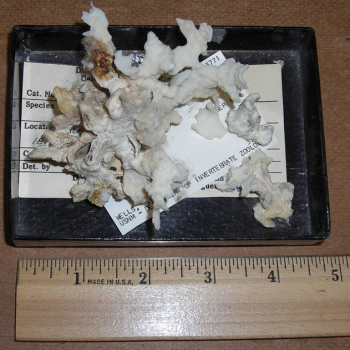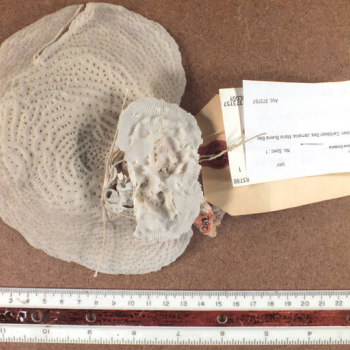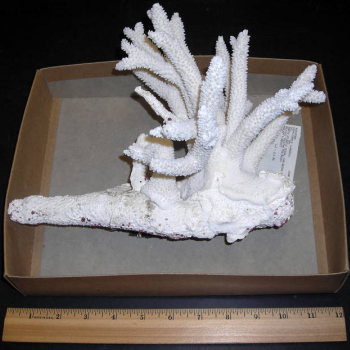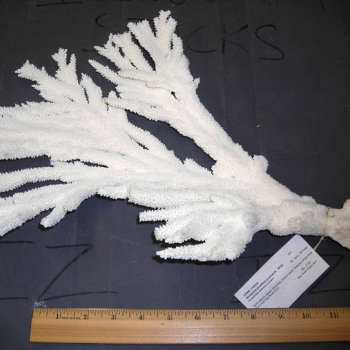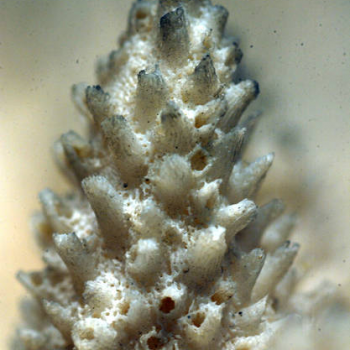Mesophotic Corals
Mesophotic reefs occur within the mesophotic (meaning “middle light”) zone of tropical and subtropical ocean regions, ranging from 100 ft (~30 m) to over 490 ft (~150 m) depth. These reefs are among the most understudied ecosystems on our planet due to their limited accessibility to researchers.
Leptoseris cailleti
Coral reefs in the mesophotic zone capture energy from residual rays of sunlight that penetrate to these depths. Species in the mesophotic zone still rely on light for energy and contain symbiotic photosynthetic algae (zooxanthellae) in their tissues, but only a small subset of species can survive in the dim mesophotic depths. Corals at greater depths in the aphotic (no light) zone survive by collecting food out of the water with their tentacles.
Leptoseris cucullata
Deep & Cold Corals
Corals are found worldwide and in every ocean basin. This cold water coral, Stylaster alaskanus, is one of over 20 species among 7 genera of hydrocorals reported in Alaskan waters.
Cold water corals are azooxanthellate, meaning they do not rely on symbiotic algae so are not restricted by light availability for survival. About half of all known coral species are azooxanthellate, and only a handful of these corals build reefs. For example, Lophelia pertusa builds cold, deep reef habitats that support diverse communities of fish and invertebrates.
Stylaster alaskanus
When we think about coral reefs, we tend to think of shallow marine ecosystems that require light to thrive. However, even at depth, corals can support vast communities of deep ocean animals.
Deep corals that don’t build large reef structures still create important habitat and influence the composition of marine biodiversity at depth.
Pocillopora molokensis
Cold water corals are azooxanthellate, meaning they don’t house algal symbionts (zooxanthellae) in their tissues. To collect energy to grow, survive, and reproduce, cold water corals feed on sinking particulate matter from shallow waters. “Marine Snow” is the term scientists use to describe the shower of organic detritus that floats down to the ocean floor from photic zones of the ocean’s surface. This transport of energy is a critical process for supporting deep sea ecosystems.
Stylaster verrillii
Cold water corals inhabiting deep ocean regions might only grow several millimeters each year. Yet, if undisturbed, these communities can grow to enormous scales - one of the largest being off the coast of Norway's Røst Island at 24.9 miles (40 km) long and 1.2-1.9 miles (2-3 km) wide.
Distichopora borealis
Reefs on the Edge
Species diversity of reef-building corals generally decreases with distance from the equator (north or south to higher latitudes). Subtropical regions therefore have fewer species than tropical regions. Corals living at the limits of their latitudinal range rely on certain traits to be successful at lower light levels, colder temperatures, and more extreme fluctuations. Many of these species are likely to be uniquely adapted to such specialized environments.
Astraea (Fissicella) flavistella
Though this species, Goniastrea favulus, is a hermaphroditic broadcast spawner like many species on the Great Barrier Reef in Australia, it is unique for its spawning method. Rather than releasing positively buoyant bundles of egg and sperm, G. favulus releases negatively buoyant eggs, followed by asynchronous bursts of sperm.
Goniastrea favulus
The unusual spawning method of G. favulus is linked to high rates of local retention and helps this species survive in marginal high latitude environments.
Goniastrea favulus
Endemic Corals
Organisms that are unique to a certain region are known as ‘endemic.’ Geographically isolated areas often have high levels of endemism. For instance, more than 25% of coral species found in the Hawaiian Islands are endemic to that region.
Pocillopora molokensis
Staghorn corals that belong to the genus Acropora are common in coral reef regions around the world. While there are over four hundred species of Acropora, only two live in the Atlantic Ocean: A. cervicornis and A. palmata (plus A. prolifera, a hybrid of the other two.)
These Atlantic acroporids are listed as Critically Endangered by the International Union for the Conservation of Nature (IUCN) due to recent, rapid population declines caused by overfishing, pollution, and habitat destruction in the Caribbean.
Acropora cervicornis
Acropora palmata
Corals that are the product of hybridization, like Acropora prolifera, aren’t successful reproducers themselves.
Acropora prolifera
Coral Migration
As ocean temperatures rise globally, coral species might adapt, die, or move. Range expansion occurs when a species migrates to more suitable regions through planktonic larval dispersal.
Geological records show that corals have migrated to higher latitudes during warmer periods in the earth’s history. Researchers have also observed range shifts over biological time scales in living corals.

